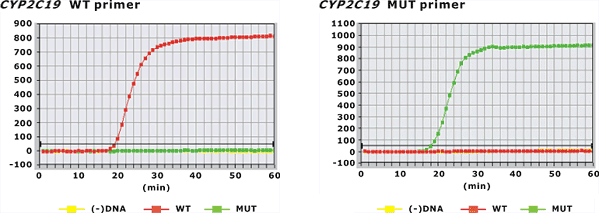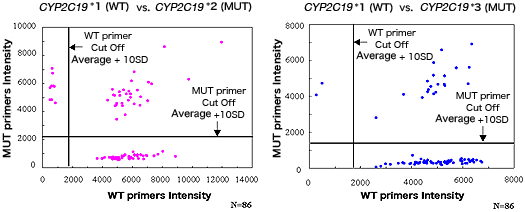- TOP
- About LAMP
- SNPs typing procedures
SNPs typing procedures
Procedures
By simply incubating genomic DNA and reagents (Primer (WT* or MUT**) , DNA polymerase with strand displacement activity, dNTPs, Reaction Buffer), including Fluorescent Detection Reagent, at a constant temperature (60°C) for a fixed period of time, SNPs typing can be achieved by derterming whether amplification has taken place.
* : Wild Type
** : Mutant Type
LAMP method allows the whole reaction process, including denaturing, to proceed at a constant temperature by incubating the reagents in a simple incubator. The presence of amplified product can be detected in a short time so as to provide a simple and rapid gene amplification method. Since 4 primers are designed to recognize 6 distinct regions on the target gene, only the target gene can be specifically amplified.
In addition, LAMP method has the characteristics of 1)no special reagents required, 2)no sophisticated temperature control device required, 3) the template can be simply detected through the presence of amplified product. Since it only requires simple equipments, cost effective gene test can be achieved. Both simple detection and real-time detection of the reaction are possible. Using Loop Primer can shorten amplification time by one third to one half.
CYP2C19 SNP typing using cloned DNA

The figures show the SNP typing results (detected by fluorescence) of CYP2C19 gene with Wild Type (WT) primers (the upper figure) and with Mutant Type (MUT) primers (the lower figure) respectively.
By using WT primers, only Wild Type template can be amplified. Similarly, MUT primers only amplify Mutant Type template. Therefore, SNP typing can be achieved by detecting the presence of the amplified product.
[Reference]
Validation of the Loop-Mediated Isothermal Amplification Method for Single Nucleotide Polymorphism Genotyping with Whole Blood
Masaomi Iwasaki, Toshihiro Yonekawa, et al. Genome Letters, Vol.2 (3) 119-126, 2003
SNP typing on human genome
The CYP2C19 gene and its family genes
In the case of SNP typing for CYP2C19 that relates to drug metabolism, only the target sequence of CYP2C19 has to be amplified among similar sequences of highly homologous genes (left figure), and furthermore, the type of SNP has to be distinguished. Since SNP typing requires very high specificity, it is extremely difficult for the reaction methods using only two types of primer and probe. However, as illustrated in this example, SNP typing can be specifically done by LAMP method as it uses 4 primers to recognize 6 distinct regions.

SNP typing on CYP2C19 using human genome specimens

The above data was obtained from the SNPs typing of human genome specimens on CYP2C19*2 allele (left) and CYP2C19*3 allele (right). This figure represents the fluorescence intensity from the reaction of Wild Type (WT) primers (horizontal axis) and the reaction of Mutant Type (MUT) primers (vertical axis) , respectively.
As a result, the following 3 types have been clearly distinguished by the respective primers: WT homogeneous samples can only be amplified by WT primers. MUT homogeneous samples can only be amplified by MUT primers. And hetero samples can be amplified by both WT and MUT primers.
- Data was collected from voluntary tests among company employees.
SNP typing using fluorescent intercalating dye
This picture shows the LAMP-based SNP typing result using Wild Type (WT) primers (amplification for WT template only) with the presence of fluorescent intercalating dye (ethidium bromide etc.). Thus, the SNP typing result can be visually confirmed after the amplification by observing the amplified product in the reaction tubes under a UV lamp.
